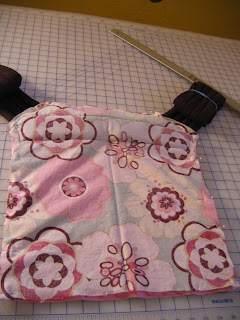I took inspiration from another blog online and these instructions combine the techniques: http://scanditute.blogspot.com/
Materials:
From http://scanditute.blogspot.com/: Strap fabric (the brown twill in the pic): “2.5 yards of strap fabric. When choosing your strap fabric - it is important to select a bottom-weight fabric like canvas, denim or twill with a minimum weight of 7 oz. Actually, 10 oz. is better. Baby cord is not strong enough for a baby carrier. NOTE: There has been a lot of recent discussion about the suitability of corduroy for mei tai straps. Cord is a compromised fabric because the pile inside the wales has been cut, thus weakening it. If you do intend to use cord for your mei tai, I can not stress enough how important it is to make sure that the cord is strong. Hold it up to the light before sewing with it. If you can see light through the fabric, it probably isn't strong enough. Cord carriers have ripped in several instances because the fabric used was not strong enough to support the weight of a baby. Please exercise utmost caution when using cord. For what it's worth, I now only make mei tais with heavy canvas (8-10 oz) or twill. In addition to being safer choices, sturdy, strong fabrics also offer the most support and comfort.”
Other fabric:
¾ yard outer design fabric. (Flower patterned cotton in the pic)
¾ yard lining fabric. (Pink Minky in the pic) Minky or Fleece works well and is snuggly soft, a friend of mine also used another design fabric and made it “reversible” (it will look a little different on the other side because of the way it is put together, but it works the same)
An 18" square of heavy canvas. (Cream colored piece you can just see under the designed fabric in the pic)
An 18" square of heavy canvas. (Cream colored piece you can just see under the designed fabric in the pic)
Some fleece or cotton batting for padding the waist and shoulder straps. (I used polar fleece, easy to work with and was cheap on sale/with coupon) This is where I cannot remember exactly how much you will need. You will need 2- 12x20 inch squares, 1- 12x17inch square, and another 2-4 layers for the padded upper piece. I think a yard is plenty, but check my math.
Thread: I used button/craft thread for sewing the straps on the canvas to make sure it is secure, but heads up, some sewing machines have a hard time sewing with this thread so check your manufacturer’s instructions for information. If it says it will be difficult to sew denim, it may be difficult to sew the canvas with this thread.
Coordinating, high-quality thread like Gutermann for the rest of the project.
Make sure you wash and press all of your fabric before beginning (I even washed the canvas and air dried to make sure I could wash and air dry the Mei Tai when it was finished).
I can tell you that I found twill on sale (40 or 50%) off, and spent about $45 total. You could get cheaper even if you really focused on shopping with coupons and for go the fancier fabric. It is well worth this price, to me, though as these carriers sell for $100 and up.
Step One- Straps:
Finished straps will be 4" wide by 74”-84" long, so measure 9" across the short end of your strap fabric (will give you a 1/2" seam allowance) and measure the length of your choice + 4” on the long end (add another 4” to the finished length for canvas attachment)
“Note: 84” are really long straps. You might want to make them up to 10" shorter. I like to tie Tibetan in a back carry, so I make them longer for me. If you decide to make the shoulder straps shorter, make sure you keep the waist strap around 80-84".”
If you desire, cut the straps at an angle on one end if you prefer a taper.
Next, sew the shoulder straps: with right sides together, stitch the straps from the point of the taper to the end. Turn right side out and press.
Now, to stuff the straps- Fold the top 8-10 inches of the strap down like you're turning down the cuff of socks. Stuff one end of the batting inside and pull the strap material up over the batting. Use kitchen tongs or a yardstick to help in keeping it flat and even. Stuff it far enough inside so that you have at least four inches of strap material left at the top. (Yes, this takes a little effort to get done) Stitch three equally-spaced lines down the length of the padding in the straps. (I did the two outer lines first and then finished with the middle line to make it easier to get the spacing even)
Step Two- Cut Body and Attach Straps:
For the body of the Mei Tai, you'll need to cute the pattern from: one layer of your decorator fabric, one layer of the liner or reverse (minky, fleece, or another decorator fabric if you want it to be reversible to that), and one layer of heavy canvas for the inside.
So, you can draw out and make your own pattern.
Now, my husband has this wonderful program called AutoCAD for his work, with which he so nicely designed a pattern for me. I can send this pattern to you if you ask for it, in PDF form, but I will warn you that it is in 11x17 format (because we conveniently have a printer this size, again for his work). The seam allowance (dotted line) for this pattern is 3/8”. This pattern is really only for the shape of the top edge and for the padded upper piece (more on that later). So, what I did was to trace the top edge p
Next you prep canvas and attach straps. First, fold down the 3/8" seam allowance on the canvas body panel where the shoulder straps will attach and press.
Then, pin the straps centered on the body. Tip: roll up the straps and secure with a rubber band to keep things neat while you're stitching.

Then you can do it all in one shot without having to cut thread and move the needle.
Step Four- Make and attach the Padded Upper:
With right sides together, sew the top edges of the outer fabric pieces together leaving the bottom edge open, turn right side out, and press with the bottom edge seam allowance folded under. Fit the fleece/batting inside this cover piece and trim if you need so this lays nice a flat. You may want to tack the fleece/batting pieces together before placing them all inside the cover. (Sorry, again I forgot a picture of this part).
Now sew the along bottom edge of the padded upper, the first horizontal line of the padding, and the edge between these two lines all to the design fabric for the Mei Tai Body. I know this is a little confusing… you can see the line I sewed in this pic (from the backside- it’s easier to see, although I sewed with it facing up):
Step Five- Assemble Body Pieces:
Stitch with a 3/8" seam allowance SKIPPING OVER the part where the shoulder straps are attached. Don't worry about stitching the bottom closed. This will be sandwiched in the waist strap anyway.
Now, at those shoulder straps, where you've folded under the canvas and liner fabrics, you'll see you now have neat layers. Fold the decorator fabric under and pin through the straps and all layers.
Topstitch around the entire body of the carrier, except the bottom, very close to the edge. You will be sewing through the padded upper in this stage. You can simply sew the edge and next horizontal line through the padding at the top edge of the Mei Tai body. Then, you can go ahead and stitch one more horizontal line through the padding to finish it. I’ve brightened up one of the pictures to show these lines a little better.
It can be tricky to catch all the layers while stitching around the padded upper, so take your time. I’ve also had to go back and sew another line at the places where the shoulder straps attach to catch all the layers and folds, and it looks fine when it’s all finished.
Step Six- Waist Strap:
Take the last strap and cut a taper on both ends if desired. Stitch right sides together, leaving an 18" hole in the center. Turn right side out and press. (I went ahead and did this when I made the first two straps)
Measure a 12"x17" piece of polar fleece, fold it like you did for the shoulder straps, insert the bottom few inches of the body of the carrier inside the padding. Here’s a pic of a different Mei Tai with the polar fleece folded around the bottom:
Sandwich the fleece and the bottom of the Mei Tai body inside the hole in the waist strap, turn the raw ends of the strap under, and pin.
Top stitch to close the opening and then stitch horizontal lines through the padding for security and comfort.
Finished! Here’s a couple that I have made so far:
Step Seven- Wear Baby and Enjoy!:
I have found this too be a comfortable and EXTREMELY versatile carrier. I've used it for front carries, hip carries, and back carries (even hiking in Yellowstone). I've also carried my older daughter (when she was almost 3) in it through Costco when she had fallen asleep in the car and wouldn't easily wake up. Here is a site that has some directions for some carries in this type of carrier: http://kozycarrier.homestead.com/instructions.html
Make sure you learn how to tie the Mei Tai safely and effectively, you are carrying precious cargo!
~ FOR PERSONAL USE ONLY ~






























